
[ Thimphu Festival Tour | Thangbi Mani Festival Tour | Jambay Lhakhang Drup Tsechu Festival Tour | Black Crane Festival Phobjikha Tour | Punakha Domchey Festival Eight Nights Tour | Punakha Domchey Festival Ten Nights Tour | Chorten Kora Tsechu (arrive Paro, Depart Paro) | Chorten Kora Tsechu (arrive Paro, exit India) | Chorten Kora Tsechu (arrive India, exit Paro) | Gom Kora Tsechu (enter Paro, exit Paro) | Gom Kora Tsechu (enter Paro, exit India) | Gom Kora Tsechu (enter India, exit Paro) | Paro Tsechu Festival Tour | Paro Tsechu Festival 7 Dzongkhags Tour | Paro Tsechu Festival Tour with Druk Path Trek | Ura Yakchoe Festival Tour ]
Chorten Kora Festival
(Enter Paro Exit India - 17 Nights 18 Days)
- Trashiyangtse, Eastern Bhutan:
Dzongkhags covered: Paro, Thimphu, Wangduephodrang, Punakha, Trongsa, Punakha, Mongar, Lhuentse, Samdrup Jongkhar, Trashigang, Trashiyangtse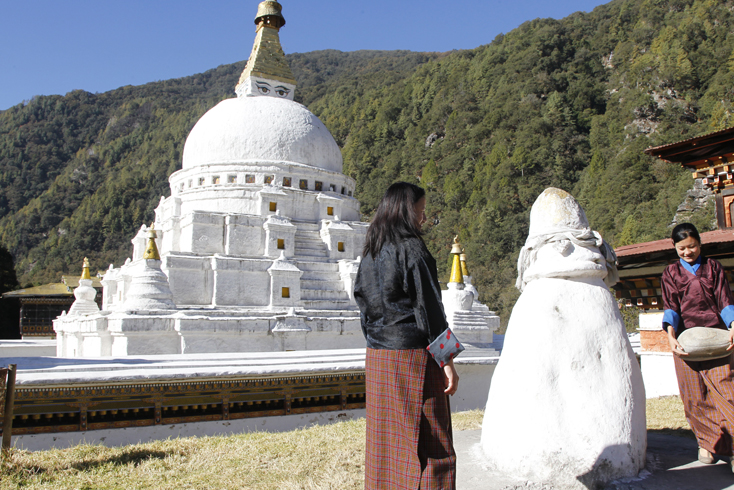
...those who carry the stone around the path will get their sins
cleansed...
Duration: 17 Nights 18
Days
Tour starts: Paro in the west; Tour ends:
Samdrup Jongkhar in the South-East
Trip Grade: Easy.
Itinerary Outline:
Day- 01 Arrive Paro International Airport
Day- 02 “Tigers Nest” to Thimphu
Day- 03: Thimphu Sightseeing
Day- 04: Thimphu – “Punakha Festival” & Wangduephodrang
Day- 05: Punakha – Trongsa
Day- 06: Sightseeing Trongsa - Drive to Bumthang
Day– 07: Bumthang Sightseeing:
Day– 08: Hike to Tang (Bumthang):
Day- 09: Bumthang – Mongar:
Day- 10: Day Excursion to remote Lhuntse, meet the weavers of the east
Day- 11: Mongar to Trashiyangtse
Day- 12: Explore Bumdeling and nearby villages famous for wooden bowls
Day- 13: Attend a unique little local Festival
Day- 14: “Chorten Kora Festival” in Trashiyangtse
Day- 15: Trashiyangtse
Day- 16: Depart Trashiyangtse for Trashigang.
Day- 17: Travel day to India border - Trashigang to Samdrup Jongkhar-
Sightseeing on way.
Day- 18: Samdrup Jongkhar to Guwahati Airport
Trip highlights:
The most comprehensive cultural adventure of the Dragon Kingdom takes us from the western to the eastern borderlands of Arunachal Pradesh, with in-depth exploration of Paro, Thimphu, Punakha, Wangduephodrang and Gangtey in the west; Trongsa and Bumthang in central Bhutan; and Mongar and Trashigang in the east. The trip expands from west to east along the lateral high way and finally concludes at Samdrup Jongkar to exit to Indian cities for your onward journeys.
In Western Bhutan, visit the famous Tiger’s Nest Monastery; vegetable market in Thimphu; the Divine Madman’s Fertility Temple and the ancient capital of Bhutan. In central Bhutan, visit Trongsa, ancestral home of the Bhutanese Royal Family; ancient temples in Bumthang valleys where first Himalayan Buddhism took hold here. We attend the climax of the country side festival at Chorten Kora in eastern Bhutan where the tantric mystic is said to have subdued the local demon. Mingle with the locals and people from the Arunachal Pradesh who have come across the border to witness the Festival. We will go to the tiny picturesque mountain villages of Radhi and Lhuentse where the finest tapestry of textiles is woven by hand. The trip is also coupled by amazing sights and day hikes in this Shangrila country whose virgin ecology and ancient traditions are kept alive.
Day -1 Arrive Paro International Airport
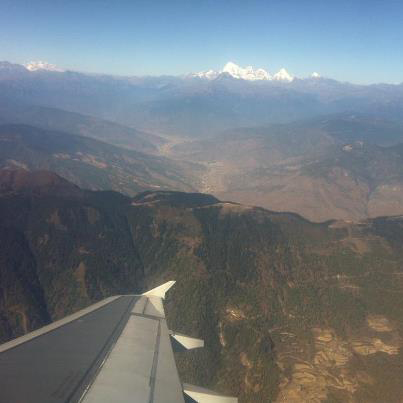 During
the flight to Paro, one will experience breathtaking views of Kanchenjunga
and other famous Himalayan peaks, including the sacred Mount Jhomolhari
and Jichu Drakey in Bhutan. (Picture on right- Druk Air approaching
Paro). At Paro airport you are received by your tour representative.
Check into your Bhutanese style resort, enjoy lunch and depart to tour
Paro village and historical Dzongs and museums in Paro. Visit the National
museum (Tag Dzong), the watch tower for the Rinpung Dzong. Tag Dzong was
converted into the National Museum in 1968, a most interesting museum
comprised of several floors displaying Bhutanese historical art and medieval
weapons. We then visit Paro Rinpung Dzong. A flagstone path rises gradually
from a beautiful wooden bridge with shingle roofing and abutted by two
guard houses, to the Rinpung Dzong. Today, the Dzong is the seat of the
district administration as well as the home for the monastic school. The
central tower (Utse) of the Dzong, with its superb woodwork, is one of
the most beautiful in the nation. The Dzong was built in 1645 A.D. We
follow up with a drive to Drugyal Dzong. The Dzong, although in ruins,
holds great historical significance. It was from this fortress that the
Bhutanese repelled many Tibetan invasions. The name means "The Victorious
Bhutanese." This spot offers a magnificent vista of Mount Jhomolhari,
"Goddess of the Holy Mountain or “Goddess of the Mountain Pass"
(Alt. 7329 m). Here is the spot many treks depart from. Also visit a typical
Bhutanese farm house on the way back and enjoy dinner in a cozy restaurant
in Paro Village. Overnight at Hotel in Paro.
During
the flight to Paro, one will experience breathtaking views of Kanchenjunga
and other famous Himalayan peaks, including the sacred Mount Jhomolhari
and Jichu Drakey in Bhutan. (Picture on right- Druk Air approaching
Paro). At Paro airport you are received by your tour representative.
Check into your Bhutanese style resort, enjoy lunch and depart to tour
Paro village and historical Dzongs and museums in Paro. Visit the National
museum (Tag Dzong), the watch tower for the Rinpung Dzong. Tag Dzong was
converted into the National Museum in 1968, a most interesting museum
comprised of several floors displaying Bhutanese historical art and medieval
weapons. We then visit Paro Rinpung Dzong. A flagstone path rises gradually
from a beautiful wooden bridge with shingle roofing and abutted by two
guard houses, to the Rinpung Dzong. Today, the Dzong is the seat of the
district administration as well as the home for the monastic school. The
central tower (Utse) of the Dzong, with its superb woodwork, is one of
the most beautiful in the nation. The Dzong was built in 1645 A.D. We
follow up with a drive to Drugyal Dzong. The Dzong, although in ruins,
holds great historical significance. It was from this fortress that the
Bhutanese repelled many Tibetan invasions. The name means "The Victorious
Bhutanese." This spot offers a magnificent vista of Mount Jhomolhari,
"Goddess of the Holy Mountain or “Goddess of the Mountain Pass"
(Alt. 7329 m). Here is the spot many treks depart from. Also visit a typical
Bhutanese farm house on the way back and enjoy dinner in a cozy restaurant
in Paro Village. Overnight at Hotel in Paro.
Day -2 “Tigers Nest” to Thimphu
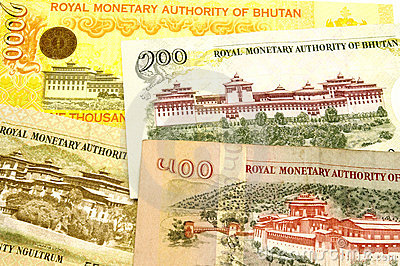 Enjoy
a hearty breakfast and depart Paro hotel for our scenic drive to Thimphu,
Capital of Bhutan. Along our route, we take a side trip to a path for
a hike up to the famous "Tiger's Nest Monastery", i.e. Taktsang
Monastery; Taktsang meaning "Tiger's Nest". 'Ta' means Tiger,
pronounced very similarly to "Tag" as in Watch and 'Ta' as in
Horse. The monastery is perched on a rocky ledge with a sheer drop of
nearly 4,000 feet. It is said that in the second half of the 8th century,
Guru Padmasambhava (Guru Rinpoche), the saint who converted Bhutan to
Buddhism, alighted here upon the back of a tigress. Spectacular and spiritual
in nature as in the mythical, Shangrila. We stop to record some memories
for later via photos and enjoy tea and snacks at the midpoint viewpoint.
Returning down the path to our vehicle we continue our drive to Thimphu.
Arriving in Thimphu, we make a stop at the Bank of Bhutan to exchange
currency (see top) and visit Bhutan’s post office.
Here you will have an opportunity to view and purchase elaborate and exquisite
Bhutanese stamps; a must for any stamp collector and great gifts as well.
Bhutanese stamps are very popular amongst stamp collecters or philatelists.
Check into our hotel, rest and relax and prepare for our reception dinner
tonight.
Enjoy
a hearty breakfast and depart Paro hotel for our scenic drive to Thimphu,
Capital of Bhutan. Along our route, we take a side trip to a path for
a hike up to the famous "Tiger's Nest Monastery", i.e. Taktsang
Monastery; Taktsang meaning "Tiger's Nest". 'Ta' means Tiger,
pronounced very similarly to "Tag" as in Watch and 'Ta' as in
Horse. The monastery is perched on a rocky ledge with a sheer drop of
nearly 4,000 feet. It is said that in the second half of the 8th century,
Guru Padmasambhava (Guru Rinpoche), the saint who converted Bhutan to
Buddhism, alighted here upon the back of a tigress. Spectacular and spiritual
in nature as in the mythical, Shangrila. We stop to record some memories
for later via photos and enjoy tea and snacks at the midpoint viewpoint.
Returning down the path to our vehicle we continue our drive to Thimphu.
Arriving in Thimphu, we make a stop at the Bank of Bhutan to exchange
currency (see top) and visit Bhutan’s post office.
Here you will have an opportunity to view and purchase elaborate and exquisite
Bhutanese stamps; a must for any stamp collector and great gifts as well.
Bhutanese stamps are very popular amongst stamp collecters or philatelists.
Check into our hotel, rest and relax and prepare for our reception dinner
tonight.
Day-3: Thimphu Sightseeing
Today we visit many historical sights in and around Thimphu: the Memorial Chorten, a large stupa built in memory of the Third King who reigned from 1952-1972; the Painting School, where traditional art is still preserved- Artists are taught to paint Thangkas here (sacred Buddhist scrolls); the Handicrafts Emporium where one can buy Bhutanese textiles and other arts and crafts; the Royal Textile Museum, displaying royal textiles and weavings of exceptional beauty and Bhutanese art forms; Semtokha Dzong, the oldest fortress in Bhutan, built in 1629 A.D. by Shabdrung Ngawang Namgyal- it also houses the largest monastic school in the country. We also visit Tashichhodzong - the main Secretariat Building. It is from this Dzong that the King and other prominent civil servants run the country. The Head Abbot, the Je Khenpo, and the central monastic body also reside here during the summer. We also visit the Takin (National Animal of Bhutan) Zoo and the Paper-House of Incense. Overnight Thimphu hotel.
Day -4 Thimphu – Punakha Festival & Wangduephodrang
After an early breakfast, drive to Punakha and Wangduephodrang. On the way, halt at Dochula Pass for a hot cup of tea/coffee and if its a clear day view a most spectacular sight of the Eastern Himalayas. We check into our hotel, enjoy lunch and depart for Punakha Dzong and the Punakha Festival in the afternoon. Being warmer than Thimphu, Punakha was the former winter capital of Bhutan. It is mow the present administrative seat of Punakha district (dzongkhag). It is also the winter residence of the central monastic body. The Dzong (fortress) lies between two rivers, the Pochu and Mochu, meaning male and female rivers (picture on the Bhutan Reborth welcome age). It was built in 1637 AD. Your senses will awake upon entering the impressive courtyard of the Punakha Dzong; “Palace of Great Happiness. It was here on 17th December 1907, Bhutan’s first king was crowned. It is time to pay respect to the Religious festival you have come to witness and capture its essence. We are privileged to be here among Bhutanese locals from many different areas who gather to pay respect and to be blessed at this social gathering. Dressed in their finest clothes and jewelry, all that attend this celebration of purification receive religious merit. Here we can truly appreciate the essence of Bhutanese People and a preserved steadfast culture. Arrays of colorful brocades whirl through the air as the dancers spin and dance the “thunderbolt step”. Masks of glorious demonic demons and animals arouse your senses as you watch the purification take place. The intensity goes on- you may be hypnotised. Return to our resort lodge for dinner and an evening visit to Wangduphodrang Dzong, perched on a promontory hilltop overlooking Wangdue and Punakha. The Dzong was built in 1638 A.D and sadly razed by fre in 2012. Renovation, however, is under way from contributions of the people from all over the country. Overnight: Resort.
Day -5 Punakha – Trongsa
This morning we return for a few hours of festival at the Punakha Dzong and then depart for a six hour scenic drive to reach Trongsa. This is a most spectacular drive! Watch for monkeys along the way. Your drive takes you along the high Himalayan highway with long climbs up and down; breathtaking and exhilarating! Look down on Trongsa Dzong for miles away from your Himalayan Highway! Check in at the hotel, owned mostly by Tibetans’, small but clean and homely with excellent food.
Day -6 Sightseeing Trongsa - Drive to Bumthang
Visit Trongsa Dzong, the ancestral home of the Royal Family and its watch tower. Built in 1648 AD, it is presently the administrative seat of Trongsa district and the home of the monastic school. Built at split levels on a narrow spur, the Dzong is an architectural wonder. The view from here extends for many kilometers and in the old days, it was a vigilance point for both the eastern and western routes. Thus, the strategic importance of this Dzong. The watch tower, located directly above the Dzong is a most impressive structure, towering over the Dzong. Here we may watch archers at play outside the walls of the Dzong. Departing Trongsa, our journey takes about 3 hrs and goes along the scenic highway. Watch for yaks along the route. Arriving Bumthang you check into your friendly and hospitable lodge.
Day – 7: Bumthang Sightseeing:
Morning: Visit the historical Jakar Dzong, built in 1646 A.D. by Minjur Tenpa, the third Druk Desi (Temporal ruler). In 1683 A.D. it was extended by Gyalse Tenzin Rabgay, the fourth Desi. Visit several ancient and sacred monasteries such as the Jambay Lhakhang, Kurjey Lhakhang, Kencho Sum Lhakhang, Tamshing and Pema Samba Lhakhangs. Also visit Membartsho "The Flaming Lake," which is considered one of the most important pilgrimage spots. A trip to the Bumthang Swiss farm is also interesting. Overnight lodge; enjoy tea and converse with your Bhutanese host.
Day – 8 Hike to Tang (Bumthang):
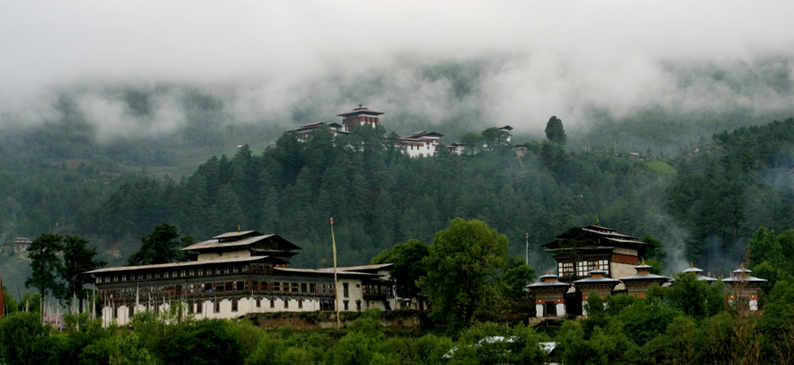
We will drive to Tang Valley and hike to visit the Ugyenchholing
Dzong (above). The Ugyenchholing Dzong was formerly the palace
of Trongsa Penlop Tsokey Dorji. You will visit the Ugyenchholing Palace,
now housing the Family Museum, a place that will transport you to another
world and time. You will view permanent exhibits recreated to capture
the ambience of the lifestyle of the Trongsa Penlop (Governor) Tshokey
Dorji and his household. Bhutan’s History unfolds. Continuing from
Ugyenchholing, we reach the Rimochen Lhakhang, a temple dedicated to Guru
Rinpoche, the Patron Saint of Bhutan. We also Visit Rimochen Temple, another
temple blessed by Guru Rinpoche and where imprints of the Saint’s
Foot and Body can be seen on the rock. In the evening we visit a farmhouse
for local hospitality and conversation. Overnight at the River Lodge.
Day - 9 Bumthang – Mongar:
After an early breakfast, gear up for a fantastic drive to Mongar. The journey is long and crosses Thrumshingla which at 3,800 metres is the highest pass. Check in at hotel/guest house. Mongar is the district headquarters but hardly more than a transit town. It is also the first town built on a slope instead of the usual valley. This is characteristic in eastern Bhutan where there are few valleys. The true homeland of the Eastern People, Sharchokpas, begins in Mongar.
 Day-
10: Day Excursion to remote Lhuentse, meet the weavers of the east
Day-
10: Day Excursion to remote Lhuentse, meet the weavers of the east
The weaving handicraft 'industry' looms large in households here and the handlooms produced are very famous. This household industry is dominated by women folks who weave different types of textiles with intricate designs. The unique weaving activities involve embroidery, basket-making and Kishuthara, a brocade dress (above weaver and Kishuthara sample in Lhuentse). Kishutharas are very beautifil which women wear as kiras (the women's dress) on special occasions like Tsechus. They are also very expensive, almost impossible for most Bhutanese to afford, some pieces fetching over 80,000 Ngultrums/US$ 1500). Textiles products of Lhuentse are stated to be the best in the country.
Day- 11: Mongar to Trashiyangtse
Morning visit Mongar Dzong. Mongar Dzong is a new Dzong, completed recently. The orginal was built in the 19th century, restored in 1953 and again in 1990 after being destroyed by a fire. The administrative seat and the monk body reside in the Dzong. Lunch at the hotel/guest house. Depart for Trashiyangtse,which lies to the North West of Trashigang. Overnight.
Day- 12: Explore Bumdeling and nearby villages famous for Wooden Bowls
 (Posing- from left to right- A Black-Necked Crane, a Wood Snipe
and a Grey-crowned Prinia)
(Posing- from left to right- A Black-Necked Crane, a Wood Snipe
and a Grey-crowned Prinia)
The Bumdeling Wildlife Sanctuary is at elevations between 1,500 metres (4,900 ft) and 6,000 metres (20,000 ft). The Sanctuary contains diverse flora, fauna, and scenery including alpine lakes and the Bumdeling Valley. The Sanctuary also contains several cultural and religious sites. It has been identified as an Important Bird Area by BirdLife International because it supports Black-necked Cranes, of which it is one of the country’s only two wintering sites (the other being Phobjikha in Wangdue), Wood Snipes and Grey-crowned Prinias. As of 2007, there was a recent record of the White-tailed Eagle, a first for the sanctuary.
Day- 13: Chorten Kora Festival in Trashiyangtse
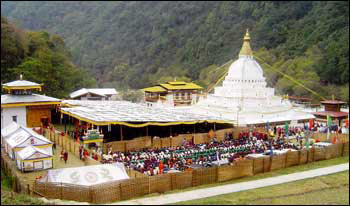 Today
we attend a remote and rural festival at the popular Chorten Kora
(left), one of the few stupas constructed in Nepali (Sherpa)
style. It was built to mark the site where Guru Rinpoche subdued many
malevolent beings. According to local tradition, the architectural model
of the stupa was brought from Nepal, carved on a radish. Chorten Kora
temple is in Trashiyangtse District in the East which adjoins the Trashigang
District. The Chorten is three minutes drive from the Trashiyangtse town.
Chorten Kora was built in 1740 by Lama Ngawang Loday. The stupa is designed
like the Swayumbhunath temple in Kathmandu, Nepal. Locals believe that
a 15 year old Tawangpa girl was sealed alive in the Stupa as an offering
of the people of Tawang, Arunachal Pradesh. Tawang people come for the
festival in the first month on the Bhutanese calendar on the 15th day.
The Trashiyangtse Dzong was built around 1656 AD in commemoration of a
Drukpa victory and renovated in 1976. This valley was of great strategic
importance in the old days because all travel to western and central Bhutan
had to pass through here.
Today
we attend a remote and rural festival at the popular Chorten Kora
(left), one of the few stupas constructed in Nepali (Sherpa)
style. It was built to mark the site where Guru Rinpoche subdued many
malevolent beings. According to local tradition, the architectural model
of the stupa was brought from Nepal, carved on a radish. Chorten Kora
temple is in Trashiyangtse District in the East which adjoins the Trashigang
District. The Chorten is three minutes drive from the Trashiyangtse town.
Chorten Kora was built in 1740 by Lama Ngawang Loday. The stupa is designed
like the Swayumbhunath temple in Kathmandu, Nepal. Locals believe that
a 15 year old Tawangpa girl was sealed alive in the Stupa as an offering
of the people of Tawang, Arunachal Pradesh. Tawang people come for the
festival in the first month on the Bhutanese calendar on the 15th day.
The Trashiyangtse Dzong was built around 1656 AD in commemoration of a
Drukpa victory and renovated in 1976. This valley was of great strategic
importance in the old days because all travel to western and central Bhutan
had to pass through here.
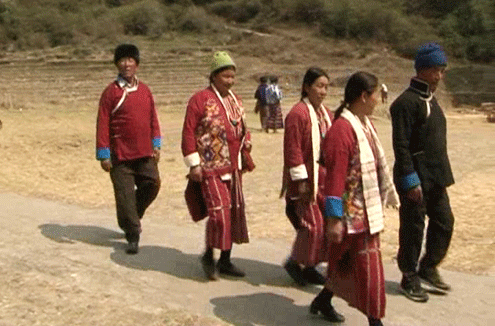 Day-
14: Chorten Kora Festival in Trashiyangtse
Day-
14: Chorten Kora Festival in Trashiyangtse
Rejoin the festival attended faithfully every year by Eastern Bhutanese and Dakpas (see right) from Tawang in Arunachal Pradesh in North-East India. Today, it is considered one of the most important historical Buddhist structures. It was built so that pilgrims could visit the temple in Trashiyangtse instead of making a trip to Nepal. Further, the legend states that a young girl from Tawang, believed to have been a Khando (Dakini) agreed to be buried alive inside the Chorten. For this reason a ritual known as Dakpa Kora is organised every year where hundreds of people from Arunachal Pradesh known as the Dakpas make it to Chorten Kora to circumambulate. Dakpa Kora is held on the 15th day of the 3rd month corresponding to 28th February and Drukpa Kora (circumbulation by the Bhutanese) is held on the 30th day corresponding to 15th March every year.
Day-15: Trashiyangtse Sightseeing
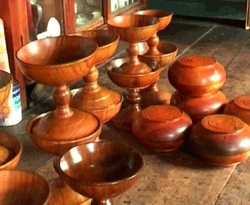 Today
we visit the traditional wood craft workshop where typical Bhutanese
bowls (known as dappas, at left) and other wooden items are made.
(These products are very popular in Bhutan). We tour Zorig Chusum, the
School of 13 Traditional Crafts; Tsenkhar ruins, which is a 20 minutes
walk from the Tsenkharla School. There are the ruins of a fort said to
have been built in the 9th Century by the Tibetan prince in exile, Lhasey
Tsangma. We visit Doksum village, where most women sit weaving outside
their house.
Today
we visit the traditional wood craft workshop where typical Bhutanese
bowls (known as dappas, at left) and other wooden items are made.
(These products are very popular in Bhutan). We tour Zorig Chusum, the
School of 13 Traditional Crafts; Tsenkhar ruins, which is a 20 minutes
walk from the Tsenkharla School. There are the ruins of a fort said to
have been built in the 9th Century by the Tibetan prince in exile, Lhasey
Tsangma. We visit Doksum village, where most women sit weaving outside
their house.
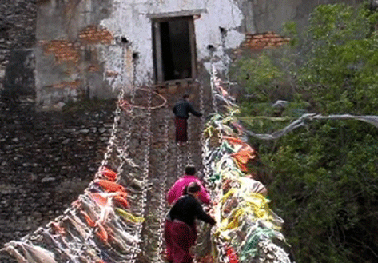 Doksum
(See right) is also the site of Bhutan’s only remaining
15th century iron chain bridge. (A day for a hike to Bumdeling to see
yaks and trout fishing can be added for relaxation and leisure).
Doksum
(See right) is also the site of Bhutan’s only remaining
15th century iron chain bridge. (A day for a hike to Bumdeling to see
yaks and trout fishing can be added for relaxation and leisure).
Day- 16: Depart Trashiyangtse for Trashigang.
Overnight lodge.
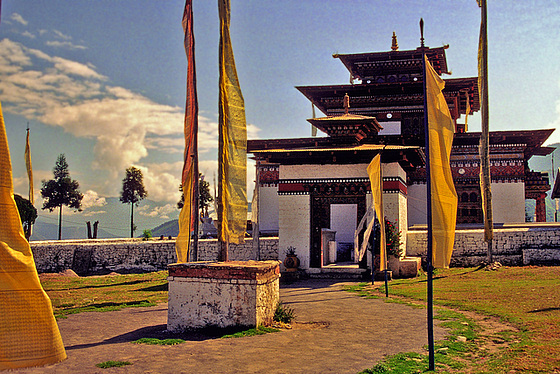 Day
-17: Travel day to India border - Trashigang to Samdrup Jongkhar:
Day
-17: Travel day to India border - Trashigang to Samdrup Jongkhar:
This is our last full day in Bhutan and we spend it mostly driving to Samdrup Jongkhar, towards the southern border where we exit into India. Along the way we will stop and visit the following places: Kanglung Temple (right); Yongphula Monastery near Kanglung and Zangtopelri temple in Wamrong.
Day -18: Samdrup Jongkhar to Guwahati Airport
After breakfast depart Samdrup Jongkhar for Guwahati Airport in the Assam State of India. Your Indian Immigration formalities will be processed at the Indian Immigration checkpoint at Kalanadi in the Nalbari district of Assam, just south of Samdrup Jongkhar. Still in the company of your main Bhutanese guide, your journey will take you through the Indian towns of Kumrikata, Tamalpu, Rangiya and finally, Guwahati. The road passes through some tea gardens between Kumrikata and Tamalpur and the rest of the journey is along the countryside of Assam interspersed with forest belts in places. You will have no problems because Bhutanese vehicles do not need permission to ply in India. The journey will take a little over 2 hours. Trashi Delek!
The group will exit via Samdrup Jongkhar to Guwahati airport, which is a little more than 2 hours, 110 km. Guwahati is connected to other Indian cities of Kolkota and New Delhi. If you wish, we can also arrange your connecting flight tickets from Guwahati to Kolkota or Delhi.
| |
BACK TO FESTIVAL TOURS MAIN PAGE |
